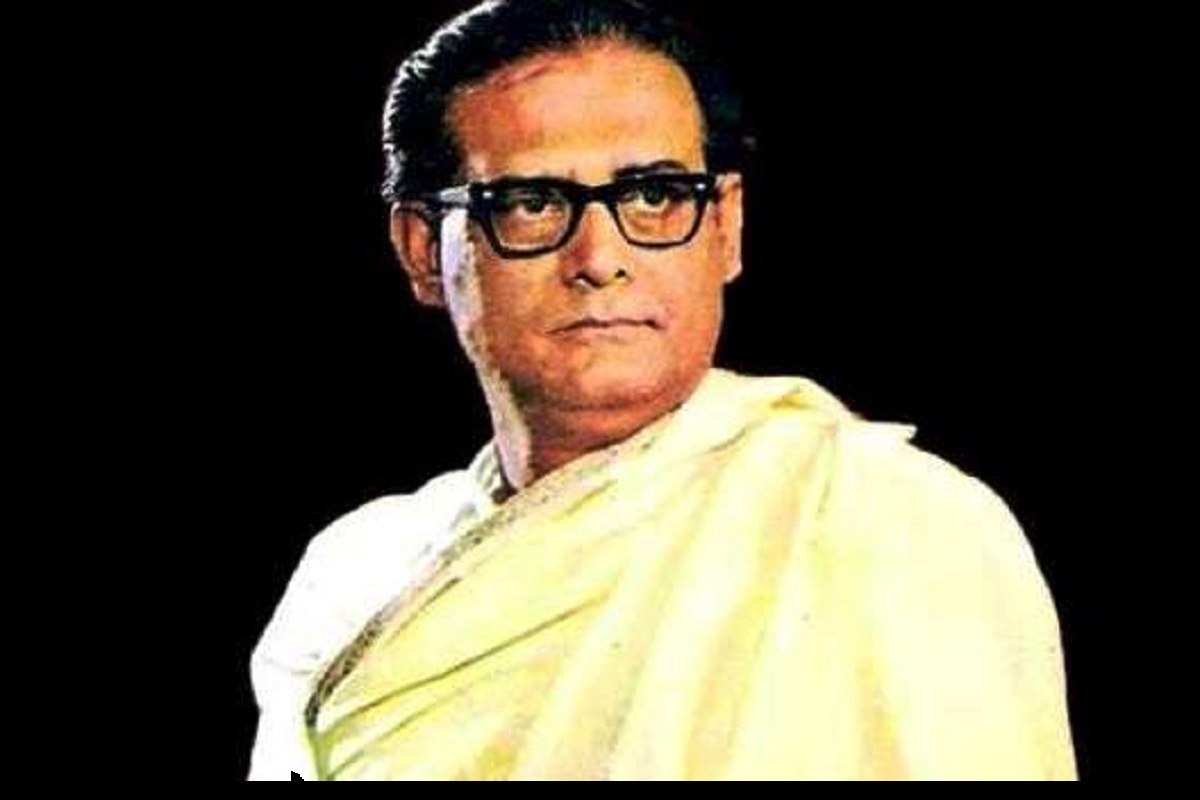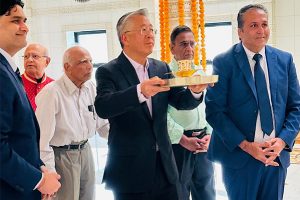In Solva Saal (1958), Waheeda Rehman tells the character played by Dev Anand that had his parents named him Hemanta Kumar it would have been nicer. Towards the end of the film the character played by Dev Anand gleefully says ‘some think my name should be Hemanta Kumar’.
Waheeda Rehman’s initial remark and Dev Anand’s subsequent endorsement in the film is a fitting tribute to a singer who was Dev Anand’s romantic voice in Hindi films in the 1950s just as he was the romantic voice for Uttam Kumar in Bengali films.
The singer too personally acknowledged that he was Dev Anand’s romantic voice much before Mohammed Rafi and Kishore Kumar. Hemanta Mukherjee (1920-89), also known as Hemant Kumar was born with a baritone voice. He entertained his school friends with his singing. His first inclination was to become a writer.
His childhood friend, Subhas Mukhopadhya who subsequently became a well-known poet himself, reminisced that at that time none could foresee that Hemanta would emerge as a great singer. Hemant was quite successful as a writer with his stories being published in Desh and Ananda Bazar Patrika.
In 1936, Hemanta got his first opportunity to sing in All India Radio with a stipulation that he could not sing a song that is copyrighted. This created a problem for him as he used to sing songs sung by Pankaj Kumar Mullick and Sachin Dev Burman imitating their styles. But Hemanta overrode the problem by singing a folk song which became popular.
This however did not deter his resolve from wanting to become a writer. By then, he had completed his school education and joined Jadavpur Engineering College. Hemanta became a literary secretary of Kalyan Sangha Library that was near his house. His close friend Ramakrishna Maitra was the editor of its handwritten magazine. Both friends contributed short stories to the publication.
Subhas wrote poems occasionally for the magazine. At its weekly meetings, the writings of its members were discussed. Many literary giants like Buddhadev Bose and Premendra Mitra were periodically invited to encourage young writers. Hemanta continued to sing on the radio but only infrequently.
The first significant appreciation of his singing abilities came from the then reigning monarch of music, Pankaj Mullick, who met Hemanta at the radio station. However, Hemanta realised that singing over the radio was not enough and needed to be supplemented with a record of his songs. After some initial disappointments, Columbia Records agreed to bring out an album.
Hemanta was still undecided about his future plans as to whether he wanted to be a singer or continue with writing. The instant popularity of his album firmly tilted the balance in favour of music. He left college and devoted his energies to music. Subhas pointed out that Hemanta did not take singing as a hobby but as a career.
He developed his own distinctive style stepping out of the shadows of both Pankaj and SD Burman. He paid attention to pronunciation of words in a song. He was both a singer and a music director who sang in films and popular songs in both Bengali and Hindi. He was also one of the finest exponents, next to Pankaj Mullick, of Rabindrasangeet.
On Tagore’s death he sang the well-known song, Jokhon Parbo Namor Payer Chinna. He was conscious of his attire, always clad in traditional white shirt and dhoti with black-frame spectacles. Later, when he started to dye his hair, his logic was simple that youngsters would not like to hear love songs from a grey-haired singer.
Hemanat joined the Indian People’s Theatre Association (IPTA) in 1944. One of the driving forces behind its foundation was the Bengal famine that saw 6 million starvation deaths. He toured the hinterland of Bengal and Assam to popularize nationalistic songs and build a sense of cultural nationalism.
Other notable active members were Khwaja Ahmad Abbas, Kaifi Azmi, Chetan Anand, Dev Anand, Mulk Raj Anand, Homi Bhabha, Anil Biswas, Harindranath Chattopadhya, Salil Choudhury, Ismat Chugtai, Utpal Dutt, Ritwik Ghatak, AK Hangal, Prithviraj Kapoor, Sahir Ludhianvi, Phani Mazumdar, Tarla Mehta, Suchitra Mitra, Dina Pathak, Balraj Sahni, Pandit Ravi Shankar and Majrooh Sultanpuri.
Hemanta along with Suchitra Mitra tried to raise money in the late 1940s for Sukanto Bhattacharya, the revolutionary poet who was then ailing from life threatening tuberculosis. Due to unavoidable reasons, Suchitra Mitra could not come but Hemanta sang with his harmonium for 90 long minutes.
He sang two of his most popular and enduring songs in 1947 ~ Ganyer badhu (the rural bride), and Ranar (runner). He did its orchestration while Salil Choudhary wrote its lyrics and composed them. Salil was underground as he was a member of the banned Communist party. He gave hints and the rest was done by Hemanta.
The latter’s records came out and became extremely popular, unfortunately in Salil’s absence. In 1950 another popular song, Abak Prithivi was composed by Salil. Initially Debabrata Sarkar and Preeti Sarkar were to sing it but the former requested Hemanta to sing the song as he had a contract with Columbia. Hemanta was essentially selftaught.
The only training he received was from Sailash Duttagupta, trainer of Columbia Records. Later he pursued classical music for a while. Despite hailing from a family of modest means he took up singing as a career at a time when other stalwarts like Pahari Sanyal, known as the uncrowned king of Lucknow and SD Burman were well off, the latter hailed from a princely family and K. L. Saigal and Pankaj Mullick had jobs.
His voice never got stereotyped; nor did it follow a particular pattern. It allowed immense flexibility. In the 1940s after securing his place as a singer and composer in Bengal, Hemanta shifted to Mumbai on Hemen Gupta’s offer to compose music for his first directorial venture in Hindi films, titled Anandmath (1952).
His and Lata Mangeshkar’s rendition of Vande Mataramfollowed by Shart (1952) and Nagin (1954) established him as a music composer and singer in Hindi films. He composed music for about 50 Hindi films and the most notables ones were Jagriti (1955), Bees Saal Baad (1962), Sahib Biwi Aur Ghulam (1962), Kohraa (1964), Anupama (1966) and Khamoshi (1968).
In the 1960s he started his film production house Gitanjali Productions that produced Bees Saal Baad, Kohraa, Biwi Aur Makaan, Fararr, Rahgir and Khamoshi. Of these, only Bees Saal Baad and Khamoshi were commercial successes. Hemant asang 13 songs for SD Burman of which 12 were picturized on Dev Anand in Sazaa (1951), Jaal (1952), House No. 44 (1955), Solva Saal (1958), Manzil (1960) and Baat Ek Raat Ki (1962).
Solva Saal’s most popular song Hai Apna Dil toh Awara sung in both joyous and melancholic versions stayed on the top of the charts of Binaca Geet Mala (1958) for one full year. The thirteenth song was Jaane Woh Kaise for Pyassa (1957). His Yeh Raat Yeh Chandni from Jaal seven decades later has more than 14 million viewers on YouTube.
Hemanta continued to maintain close links with Kolkata shuttling between Mumbai and Kolkata in the 1950s and Sixties. He produced under his own banner Hemanta- Bela productions ***Neel Akasher*** Neeche (1959), a Bengali adaptation of Mahadevi Verma’s ***Chini Phiri Wallah*** that severely critiqued British imperialism and preached universal humanism.
A meticulous Hemanta did not approve of the first draft of the screenplay by Mrinal Sen and chose instead Shantu Mukherjee to write it. He was also the music director Conrad Rooke’s Siddhartha (1972) based on Herman Hesse’s story with an Indian background. Here he used two of his bestknown songs, O Nadi Re and Pather Klanti Bhule.
Hemanta took part in practically every celebration of Tagore’s birthday on 25th Baishak in Kolkata with his towering presence and melodious rendition of his songs. Hemanta used western tunes for the songs that Kishore Kumar sang, singing tobu naam tar shingo.
He was of the view that it is important to acquire the best at a time when the world has become really small; when we are listening to western music and the West is listening to us. This simple formula he pursued throughout his life and on reaching perfection he immortalized himself in Bengali music in particular and in Hindi songs in general.
(The writers are respectively retired Professor in Political Science, University of Delhi, and Associate Professor in Political Science, Jesus and Mary College, New Delhi)











